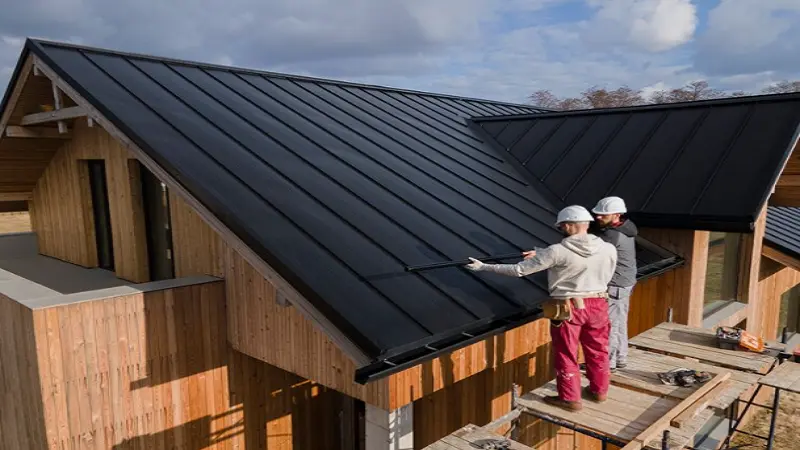
When roofing, selecting the right material for your home is crucial. It impacts your home’s appearance, durability, and energy efficiency. With numerous options available, finding the best roofing material might seem overwhelming. However, by considering a few key factors and seeking expert advice from reputable Roofers Burlington, you can make an informed choice that suits your needs and budget. Here’s a guide to help you navigate the options and find the right roofing material for your home.
1. Understand Your Roofing Needs
Before you start shopping for roofing materials, it’s essential to assess your specific needs. Consider the following factors:
- For instance, homes in areas with heavy snowfall or rain need materials that can withstand harsh weather conditions.
- Roof Pitch: The pitch or slope of your roof affects the type of materials you can use. Steeper roofs can handle a wider range of materials, while flatter roofs might require specific options.
- Aesthetics: The appearance of your roof can enhance or detract from your home’s overall look.
2. Explore Roofing Material Options
They come in various colors and styles, making it easy to find an option that suits your home.
They can withstand extreme weather conditions and are available in various styles, including panels and shingles. Metal roofing is also energy-efficient and environmentally friendly.
Clay and Concrete Tiles: These materials offer a distinct, Mediterranean look and are highly durable. They are ideal for homes in hot climates but may require additional support due to their weight.
They are available in cedar, redwood, and other woods. However, they require regular maintenance and treatment to prevent rot and pests.
It is highly durable and can last for over a century. However, it is more expensive and requires professional installation.
3. Consult with Local Roofers
Finding the right roofing material is easier when you consult with local professionals. Roofers in Burlington and Etobicoke, such as those from Above It All Roofing, can provide valuable insights into the best materials for your area. They are familiar with local climate conditions and building codes, ensuring you make a choice that meets all requirements.
Experience and Reputation: Look for roofers with a solid track record and positive customer reviews. Experienced contractors will have the knowledge to guide you in selecting the best material for your home.
Licensing and Insurance: Ensure the roofing company is licensed and insured. This protects you in case of any issues during installation.
Quotes and Warranties: Obtain quotes from multiple contractors and compare them. Also, inquire about warranties on both the materials and workmanship.
4. Visit Roofing Material Suppliers
Once you have a shortlist of materials, visit local suppliers to see the options in person. This allows you to inspect the quality and appearance of the materials before making a final decision. You can also get expert advice from suppliers who can provide additional information about the benefits and drawbacks of each material.
Many suppliers offer samples, so take advantage of this to see how different materials look on your home. This can help you visualize the result and make a more informed choice.
5. Consider the Long-Term Costs
While initial costs are important, it’s also crucial to consider the long-term expenses associated with different roofing materials. Some materials may have a higher upfront cost but lower maintenance and replacement costs over time. For example:
- Asphalt Shingles: These are affordable but may need to be replaced more frequently.
- Metal Roofing: Although more expensive initially, metal roofs can last up to 50 years or more with minimal maintenance.
- Slate Roofing: Slate offers longevity but comes with a high price tag.
Factor in both the installation and maintenance costs when making your decision. A more expensive material might be a better investment if it lasts longer and requires less upkeep.
6. Evaluate Energy Efficiency
Energy efficiency is another critical consideration. Roofing materials can impact your home’s energy consumption and comfort. For instance:
- Metal Roofs: These reflect sunlight, reducing cooling costs in hot climates.
- Asphalt Shingles: Modern shingles with reflective coatings can also improve energy efficiency.
- Cool Roofing Options: Some materials are designed to absorb less heat, which can help maintain a comfortable temperature inside your home.
Choosing energy-efficient roofing can help lower your utility bills and reduce your environmental footprint.
7. Make Your Decision
After gathering all the necessary information and consulting with experts, it’s time to make your decision. Choose a roofing material that fits your budget, complements your home’s style, and meets your specific needs.
Remember, the right roofing material not only enhances your home’s appearance but also provides protection and energy efficiency. By working with experienced professionals like Above It All Roofing and consulting with local Roofers in Etobicoke, you can ensure that your roofing investment is both practical and long-lasting.
In summary, finding the right roofing material involves understanding your needs, exploring available options, consulting with local roofers, and evaluating both short-term and long-term costs. By taking these steps, you can select a roofing material that will keep your home safe and stylish for years to come.
Conclusion
Choosing the right roofing material for your home is a significant decision that impacts both its aesthetic appeal and long-term performance. By considering factors such as your local climate, roof pitch, and aesthetic preferences, you can narrow down your options to find the best fit. Exploring various materials, consulting with experienced professionals like Above It All Roofing, and visiting local suppliers will provide you with valuable insights and help you make an informed choice.








